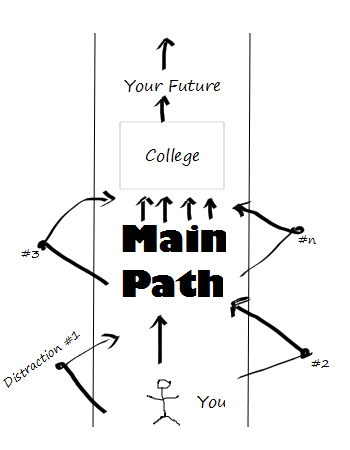Stay Focused – Stick To The “Main Path”
Ok, I’ll admit it – as someone who has a very broad range of interests, knowing how to stay focused, particularly early in my career, has at times been a challenge for me. Probably like most of you who are “afflicted” with broad interests and a desire to learn as much as you can about each one, I don’t really feel as though I should apologize for this “affliction,” rather I remain keenly aware that I must keep it under control. This requires the ability, and perhaps more importantly, a proven approach, to handle “shiny object syndrome” and stay on track.
While there are many ways to deal with shiny object syndrome and other external and internal factors that may cause you to lose focus, I have a particular metaphor that my brother taught me that has been very useful for me for over 20 years now. For lack of a better name, I’ll call it the “Main Path Approach” to maintaining focus and perspective.
I still remember vividly exactly where I was when my brother explained the Main Path Approach to me. I was still in high school and had just cooked up another far-fetched idea for what I intended to do immediately after graduating. Honestly, I don’t recall exactly what it was, but most likely it involved flying or sailing to some far-away place and living off the land, or becoming a pirate, or something like that. Those types of ideas occurred to me (more) frequently back then, and while my family largely tolerated them, they all had one clear goal in mind for what they wanted me to do: go to college.
So on this particular day, I was with my brother, telling him about my latest idea. He listened, said it sounded interesting, then explained to me the Main Path Approach, for which he also drew me the following diagram (roughly).

The idea, as you can see, is that you’re at some starting point and there’s a “Main Path” that you need to follow. You can stray from the Main Path, but you must always return to it, so that you accomplish what I guess you could call your “Main Goal”. In this case, as I mentioned, the Main Goal that he and the rest of my family had for me was going to and finishing college, which would then lead to my future. In your particular case, at this point in your life, your Main Goal may be something entirely different than college – this example is just used for illustration purposes.
I think my favorite part of this diagram, at the time and to this very moment, was the little segments that go off the Main Path, then come back. I loved the fact that they gave me license to try other things and still be a bit adventurous. My brother and the rest of my family were smart enough and knew me well enough that if they pushed me to ONLY stay on the Main Path, it would cause me to go crazy and I would rebel. I still feel that way to this day. We have to give ourselves license to deviate from the Main Path, as long as it’s always with the knowledge that we’ll come back and accomplish our Main Goal. For some people this “license” to deviate a bit is more important than it is for others.
What is your Main Goal at this time? What should your Main Path look like? If you have not done the goal-setting you need to determine the answers to these questions, I highly encourage you to do so. If you don’t have a “Main Goal” (or Main Goals, if you so choose), it is very tough to determine what the Path should look like, and as a result, it’s highly likely that you will flounder or head down “rat holes,” from which you won’t know how or where to return.
P.S. I’m not sure I ever thanked my brother for this diagram and metaphor, but just in case: Thanks, Rob. It’s been very useful to me, particularly in those times when I’ve known I got off the Main Path and needed to know which direction to head to get back.
I look forward to your thoughts and questions. Please leave a comment (“response”) below or in the upper right corner of this post.



This “license” you speak of is the breather we sometimes need. = )
Agreed, María. Staying focused can be tiring. It is important to allow yourself that “breather” from time to time, otherwise you can easily fall of the Main Path altogether.
I think I suffer from the same “shiny object syndrome”. Thoughtout my life I have had a ton of crazy hobbies and ideas but seems as I get older I leave the path a lot less.
I’ve actually been thinking about this a lot lately, and questioning what my “main path” really is. I’ve got my classes, my job as an RA, and my second job taking up lots of my time; however, I get the most satisfaction and value from my entrepreneurial projects. At this point, I’m feeling like even my classes aren’t very useful anymore, and it’s pretty hard to stay interested in them! I’m looking forward to next summer, so I can see what it’s like to work on a single project instead of juggling lots at the same time.
I think we all suffer from shiny object syndrome to some extent. It just seems to be human nature. I like your comment about leaving the path less as you get older. That could be due to a variety of factors, but in the end, if you feel as though what you’re doing is fulfilling enough, you won’t feel the need to leave the path as much! Thanks for your comments. Paul
Wow, your situation sounds very familiar to me … about 24 years ago! It can be summarized as college plus all kinds of other distractions. I was similar, in that my entrepreneurial projects were always what fascinated me the most. The key is to not “spread yourself too thin” — you don’t want to be doing so many things at one time that you can’t be good at any of them! Another useful approach I’ve found when I’m inundated with many projects from diverse areas of my life is to designate particular times of the day for each project, to the extent this is possible. This can be helpful for getting your mind in a rhythm that allows you to be more productive on all projects.
College should be displayed as a “distraction” in the above image, not part of the “main path”.
College is the most expensive shiny object there is, which unfortunately also turns out to be the biggest time waster.
In some cases, that definitely is the case.
It certainly can be. I agree with this, as well as your other comment about college being the “most expensive shiny object there is”. I don’t think it’s universally true, like most things, but it applies in many cases.